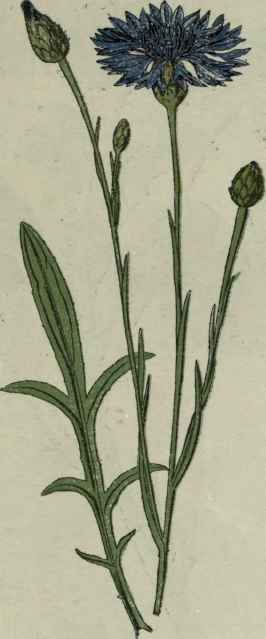Bluebottle Or Cornflower (Centaurea Cyanus)
Description
This section is from the book "Wayside And Woodland Blossoms", by Edward Step. Also available from Amazon: Wayside And Woodland Blossoms: A Guide To British Wild-Flowers.
Bluebottle Or Cornflower (Centaurea Cyanus)
The Centaureas are closely allied to the thistles, and share with them that hard-headedness which makes the thistle so good a type of the canny Scot. The Bluebottle must not be sought in the company of the thistles on wastes and in neglected corners of pasture, but, as one of its folk-names indicates, in the cornfield. Beginning to flower in June, it keeps up the display of bright blue until the reapers cut it down.
Bluebottle is a composite flower, and it should afford interest to the reader, when he finds the blossoms, to institute a comparison between it and that of the Daisy or other of the Composites we have already described.
The thin stem is but slightly branched, and the long lower leaves are much cut up and very attenuated. Nearer the summit of the stems the leaves are simpler, and reduced to a very slight width. The stems and the under sides of the leaves are covered with loose cottony fibres. The flower-heads have for involucre a number of greenish scales, with toothed brown margins. The ray-florets are bright blue, their free ends divided into five teeth; the inner or disc-florets are much darker. The stamens are irritable, and if touched withdraw into the tube.
There are five other British species of Centaurea, of which several are rare or extremely local in their distribution. The more frequent species are:
I. Black Knapweed (C. nigra). Leaves rough, entire or lobed, the lower ones with stalks. The heads large and globose, as much as an inch and a half in diameter. Involucral scales circular, brown, toothed. Florets purple. Common in meadows and pastures. June to September.
II. Greater Knapweed, or Hard Heads (C. scabiosa). The leaves are deeply pinnate, like the lower ones of Bluebottle. Heads as much as two inches diameter. Involucral scales cottony, with dark brown, almost black, margin, and paler fringe. Florets rich purple. Waste places. July to September.

Cornflower. Blue-bottle.
Gentaurea cyanus. - Compositae. -
Continue to:


